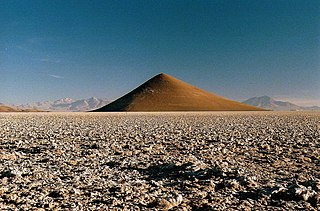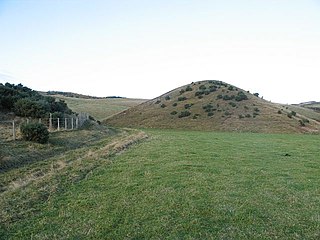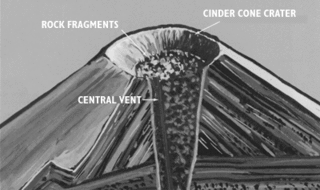
Paratoari (also known as the Pyramids of Paratoari, Pyramids of Pantiacolla or "The Dots") is a site composed of pyramid-shaped natural formations in the Manu area of dense tropical rainforest in southeast Peru. It was first identified via NASA satellite photograph number C-S11-32W071-03, released in 1976. They subsequently garnered greater attention among South America aficionados through a series of three articles which questioned from afar what "The Dots" might truly represent (and settled upon a geological explanation being the most plausible) in 1977 - 1979 issues of the "South American Explorer" journal, written under the name of "Ursula Thiermann" by Don Montague, president of the South American Explorers Club.

Peru, officially the Republic of Peru, is a country in western South America. It is bordered in the north by Ecuador and Colombia, in the east by Brazil, in the southeast by Bolivia, in the south by Chile, and in the west by the Pacific Ocean. Peru is a megadiverse country with habitats ranging from the arid plains of the Pacific coastal region in the west to the peaks of the Andes mountains vertically extending from the north to the southeast of the country to the tropical Amazon Basin rainforest in the east with the Amazon river.

The National Aeronautics and Space Administration is an independent agency of the United States Federal Government responsible for the civilian space program, as well as aeronautics and aerospace research.
The next 20 years were filled with speculation as to the formations' true nature, as they appeared to be symmetrically spaced and uniform in shape, looking like a series of eight or more pyramids, in at least four rows of two. In August 1996 Boston-based explorer Gregory Deyermenjian of The Explorers Club, along with Peruvian partners Paulino Mamani, Dante Núñez del Prado, Fernando Neuenschwander, Ignacio Mamani, and Machiguenga "Roberto", his wife "Grenci" and their baby daughter "Reina", were first to make an on-site exploration. Their survey identified Paratoari as natural sandstone formations, not as symmetrical in placement or as uniform in size as suggested by their image on the satellite photograph, and without any sign of the influence of ancient culture.

Boston is the capital and most populous city of the Commonwealth of Massachusetts in the United States, as well as the 21st most populous city in the United States. The city proper covers 48 square miles (124 km2) with an estimated population of 694,583 in 2018, making it also the most populous city in New England. Boston is the seat of Suffolk County as well, although the county government was disbanded on July 1, 1999. The city is the economic and cultural anchor of a substantially larger metropolitan area known as Greater Boston, a metropolitan statistical area (MSA) home to a census-estimated 4.8 million people in 2016 and ranking as the tenth-largest such area in the country. As a combined statistical area (CSA), this wider commuting region is home to some 8.2 million people, making it the sixth most populous in the United States.
Gregory Deyermenjian is a psychologist and explorer. In 1981 he visited the ruins of Vilcabamba la Vieja at Espíritu Pampa, and then turned his attention to the northeast and north of Cusco, Peru. Since the mid-1980s he has made numerous expeditions to Peru investigating Paititi, a legendary lost city that is part of the history and legend of the western Amazon basin. He is a long-term Fellow of The Explorers Club.

The Explorers Club is an American-based international multidisciplinary professional society with the goal of promoting scientific exploration and field study. The club was founded in New York City in 1904, and has served as a meeting point for explorers and scientists worldwide.
The formations, which are at the edge of a higher area that breaks down into lower jungle, were argued to be a natural landform, which is known as truncated ridge spurs (as put forth 17 years previously in the last of the three "Ursula Thiermann" articles). However, according to pictures in these articles, these formations are another natural landform, which geomorphologists refer to as a "flatiron". Deyermenjian has since, in 1999 and 2006, seen and photographed various very similar sites in the area of the Río Timpía, with intriguingly pyramidal-shaped huge natural formations.

A landform is a natural or artificial feature of the solid surface of the Earth or other planetary body. Landforms together make up a given terrain, and their arrangement in the landscape is known as topography. Typical landforms include hills, mountains, plateaus, canyons, and valleys, as well as shoreline features such as bays, peninsulas, and seas, including submerged features such as mid-ocean ridges, volcanoes, and the great ocean basins.

A truncated spur is a spur, which is a ridge that descends towards a valley floor or coastline from a higher elevation, that ends in an inverted-V face and was produced by the erosional truncation of the spur by the action of either streams, waves, or glaciers. Truncated spurs can be found within mountains, along the walls of river valleys, or along coastlines.

Traditionally in geomorphology, a flatiron is a steeply sloping triangular landform created by the differential erosion of a steeply dipping, erosion-resistant layer of rock overlying softer strata. Flatirons have wide bases that form the base of a steep, triangular facet that narrows upward into a point at its summit. The dissection of a hogback by regularly spaced streams often resulted in the formation of a series of flatirons along the strike of the rock layer that formed the hogback. As noted in some, but not all definitions, a number of flatirons are perched upon the slope of a larger mountain with the rock layer forming the flatiron inclined in the same direction as, but often at a steeper angle than the associated mountain slope. The name flatiron refers their resemblance to an upended, household flatiron.











